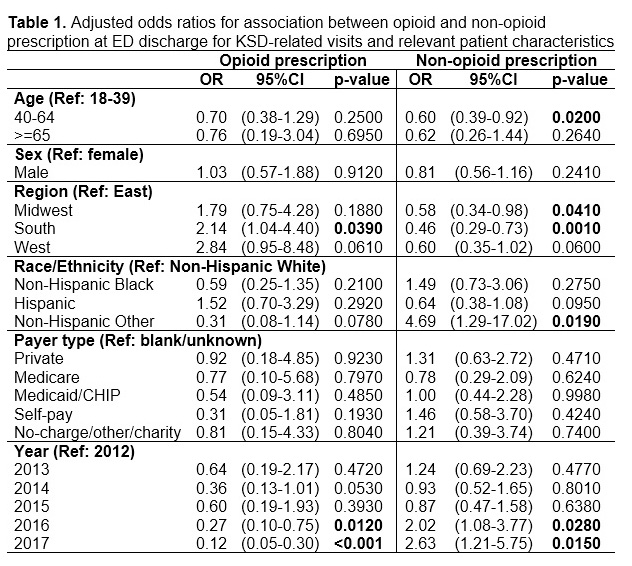Back
Poster, Podium & Video Sessions
Moderated Poster
MP26: Stone Disease: Epidemiology & Evaluation I
MP26-12: Changing National Trends in Opioid Prescriptions for Pain Management in Acute Kidney Stone Disease
Saturday, May 14, 2022
10:30 AM – 11:45 AM
Location: Room 225
Chinmayee Katragadda, Alexis Steinmetz*, Alexander Cranwell, Rajat Jain, Rochester, NY
.jpg)
Alexis R. Steinmetz, MD
University of Rochester Medical Center, Dept. of Urology
Poster Presenter(s)
Introduction: Deaths from opioid-related overdose contributed to the decline in life expectancy seen in the US from 2014-2018 and surpassed deaths from automobile accidents. Urologic surgery and disease, including benign conditions such as kidney stone disease (KSD), are a significant source of opioid prescriptions. We investigated prescription patterns for opioids and non-opioids for KSD in the Emergency Department (ED) setting. These data provide important information as urologists seek opioid sparing approaches and effective alternative therapies for the KSD population.
Methods: The US National Hospital Ambulatory Medical Care Survey (NHMACS) was queried for ED visits for KSD from 2012 to 2017. Adult patients with KSD-related diagnoses that visited the ED were identified using International Classification of Diseases codes. Prescription rates of opioids and non-opioids were analyzed with respect to age, sex, region, race/ethnicity, and payer type. Survey weighted chi-square and logistic regression, and adjusted odds ratios were used to analyze associations.
Results: Six million KSD-related ED visits were identified. The percentage of patients receiving opioid prescriptions decreased from 33% to 16% from 2012-2017 (p-trend <0.001) while non-opioid prescriptions rose from 67% to 84% in that same time period (p-trend <0.02). Compared to 2012, the odds of receiving an opioid prescription decreased significantly in 2016 and 2017 (OR 0.27, p=0.01 and OR 0.12, p<0.0001, respectively). There was a concurrent increase in the odds of receiving a non-opioid prescription in 2016 and 2017 (OR 2.02, p=0.03 and OR 2.63, p=0.01 respectively). Payer type, episode of care and gender were not associated with type of prescription.
Conclusions: The dramatic decrease in opioid prescriptions for kidney stone disease has been accompanied by a concomitant rise in non-opioid prescriptions. This represents a fundamental shift in the management of pain in acute kidney stone disease which is reflective of the nationwide public health effort to curb the opioid epidemic.
Source of Funding: N/A


Methods: The US National Hospital Ambulatory Medical Care Survey (NHMACS) was queried for ED visits for KSD from 2012 to 2017. Adult patients with KSD-related diagnoses that visited the ED were identified using International Classification of Diseases codes. Prescription rates of opioids and non-opioids were analyzed with respect to age, sex, region, race/ethnicity, and payer type. Survey weighted chi-square and logistic regression, and adjusted odds ratios were used to analyze associations.
Results: Six million KSD-related ED visits were identified. The percentage of patients receiving opioid prescriptions decreased from 33% to 16% from 2012-2017 (p-trend <0.001) while non-opioid prescriptions rose from 67% to 84% in that same time period (p-trend <0.02). Compared to 2012, the odds of receiving an opioid prescription decreased significantly in 2016 and 2017 (OR 0.27, p=0.01 and OR 0.12, p<0.0001, respectively). There was a concurrent increase in the odds of receiving a non-opioid prescription in 2016 and 2017 (OR 2.02, p=0.03 and OR 2.63, p=0.01 respectively). Payer type, episode of care and gender were not associated with type of prescription.
Conclusions: The dramatic decrease in opioid prescriptions for kidney stone disease has been accompanied by a concomitant rise in non-opioid prescriptions. This represents a fundamental shift in the management of pain in acute kidney stone disease which is reflective of the nationwide public health effort to curb the opioid epidemic.
Source of Funding: N/A



.jpg)
.jpg)